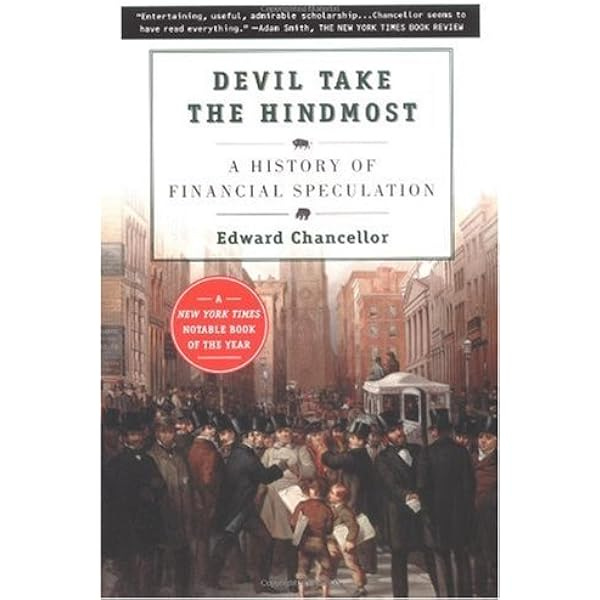Book Summary: Devil Take the Hindmost - A History of Financial Speculation
Classic on manias, bubbles and crashes
Note: If you’re interested in reading the book, I’ve included the Amazon link below. I’ll receive a small commission from each sale.
About the Author: Who Is Edward Chancellor?
Edward Chancellor, the author of "Devil Take the Hindmost: A History of Financial Speculation," possesses a rich educational background and a diverse work history that has contributed to his expertise in financial history and investment management.
Chancellor graduated with honors from Trinity College, Cambridge, where he studied history. His educational foundation in history likely provided him with a unique perspective on the long-term trends and historical contexts that shape financial markets.
Following his academic pursuits, Chancellor delved into the world of finance, gaining practical experience that would later inform his writings. He worked as an investment analyst for Guinness Flight Global Asset Management, where he honed his skills in analyzing financial markets and understanding the dynamics of investment decision-making.
His career continued to evolve as he transitioned to the role of managing director at Grantham, Mayo, Van Otterloo & Co. LLC, a renowned global investment management firm. This experience likely deepened his understanding of the intricacies of portfolio management, risk assessment, and the broader financial industry.
His work, including "Devil Take the Hindmost," reflects not only a keen understanding of financial history but also a practical awareness of the challenges and opportunities present in the ever-changing world of finance.
Book Summary:
"Devil Take the Hindmost: A History of Financial Speculation," published in 1999, stands as a compelling exploration of the ebbs and flows of financial markets throughout history. Chancellor brings a unique blend of academic insight and practical experience to his examination of the speculative manias and market crashes that have defined the world of finance. Within the pages of this meticulously researched work, Chancellor unravels the threads of historical episodes, from the infamous Tulip Mania to the roaring 1920s, providing readers with a panoramic view of the recurring patterns that characterize financial bubbles. The book serves not only as a cautionary tale but also as a guide for understanding the deep-seated human psychology, regulatory responses, and the impact of financial innovations that contribute to the cyclical nature of financial markets. Through Chancellor's narrative, readers embark on a journey that transcends time, gaining insights that remain pertinent for navigating the complexities and uncertainties of contemporary financial landscapes.
Key Insights:
1. Tulip Mania and Other Bubbles: Chancellor explores various historical bubbles, such as Tulip Mania in 17th-century Holland, the South Sea Bubble in 18th-century England, and the speculative excesses of the Roaring Twenties. Commonalities across these episodes include a rapid surge in asset prices fueled by speculative trading, followed by a dramatic collapse. In each case, the initial rise often had some basis in economic fundamentals, but the speculative frenzy quickly detached from reality, driven by the belief that prices could only go up.
2. Role of Human Psychology: Greed and fear are powerful drivers of market behavior. During boom periods, greed motivates investors to chase rising prices, often fueled by the fear of missing out (FOMO). This herding behavior contributes to the formation of asset bubbles. Conversely, when fear takes hold during a market downturn, panic selling can lead to a rapid and severe decline in prices. Chancellor illustrates how these emotional extremes create a cycle of boom and bust, as investor sentiment swings between exuberance and despair.
3. Regulatory Response: Chancellor discusses the historical development of financial regulations in response to speculative excesses. While regulations aim to prevent market manipulation and protect investors, they often struggle to keep pace with financial innovation and changing market dynamics. The effectiveness of regulatory measures is a recurring theme in the book, with Chancellor highlighting instances where regulations succeeded in restoring stability and cases where they fell short, allowing speculative excesses to persist.
4. Market Innovations and Financial Instruments: The book explores how financial innovations and new instruments contribute to speculation and risk. Chancellor discusses the development of options trading, futures contracts, and other derivatives that provide investors with new tools for speculation. While these innovations can enhance market efficiency, they also introduce complexity and risk. The author argues that the misuse or misunderstanding of these instruments can amplify market volatility, as seen in events like the 2008 financial crisis, where complex mortgage-backed securities played a central role.
Chancellor emphasizes that market innovations are double-edged swords, offering opportunities for profit but also creating the potential for systemic risk. The interplay between financial innovation, speculation, and risk underscores the need for vigilant regulation and risk management to maintain market stability.
Conclusion - Takeaways for Readers: Readers should take away a nuanced understanding of the recurring patterns in financial history, recognizing the influence of human psychology, the limitations of regulatory measures, and the dual nature of financial innovations. The book serves as a cautionary guide, urging investors and policymakers to remain vigilant against the irrational exuberance and excessive risk-taking that have historically led to market downturns. As financial markets evolve, the lessons from "Devil Take the Hindmost" remain relevant for those seeking to navigate the complex world of finance.
Further Reading:
"Extraordinary Popular Delusions and the Madness of Crowds" by Charles Mackay: This classic work, originally published in 1841, explores the psychological dynamics behind historical financial bubbles, providing additional historical context to Chancellor's analysis.
"Manias, Panics, and Crashes: A History of Financial Crises" by Charles P. Kindleberger: Kindleberger's book offers a comprehensive examination of financial crises, drawing on historical examples to analyze the common patterns and factors that contribute to economic downturns.




I have this book and this is a great summary - thanks, Sarah!